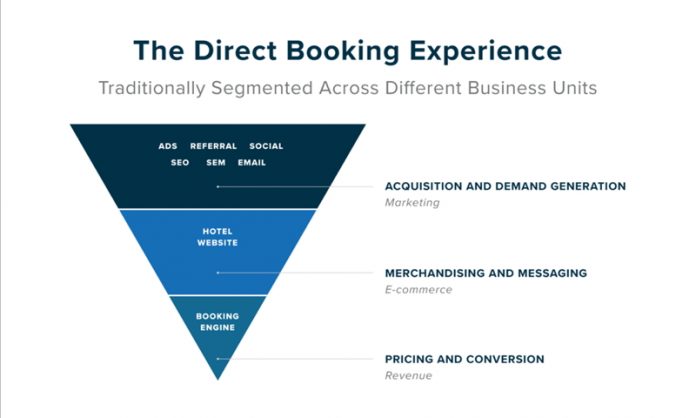While leisure and even group travel is starting to rebound en masse, from shifting markets to consumer privacy changes, there’s just no denying the extent to which the pandemic has reshaped the hospitality industry.
NB: This is an article from Cendyn, one of our Expert Partners
Major shifts in guest expectations and the role of digitization are impossible to ignore when it comes to preparing for future success. In order for you to understand who your guests are and what they want, it’s important to unify the first-party data you own and build on those insights.
Subscribe to our weekly newsletter and stay up to date
However, when that data is trapped in disjointed tech stacks that don’t speak to each other, those insights remain hidden from the teams it can help the most: Marketing, eCommerce, and Revenue. That’s because each of these teams tends to operate within their own silo, with marketing responsible for top-of-funnel acquisition activities like targeted ad campaigns, eCommerce focusing on your website experience and direct channel messaging, and revenue’s price setting and booking engine experience.
When you align Marketing, eCommerce and Revenue systems and goals, these teams can work together to create a compelling strategy across all channels and guest touchpoints. When these functions remain fragmented, each stage of the booking journey is handled by a separate team with incomplete information, resulting in less revenue and a suboptimal guest experience.
Aligning goals and processes is hard, but worth it
From a strategy perspective, silos of data and processes typically extend different departments within the funnel – with each group optimizing their own part without understanding how those decisions are impacting other departments and their goals.
For example, marketers are generally incentivized to deliver a high volume of traffic to the website, so they spend their time devising new ways to bring in more visits. E-commerce leaders are incentivized to boost conversion rate on site, so they work with technology to merchandise and discount more dynamically. And revenue professionals are incentivized to protect ADR, manage inventory, and protect channel parity, so their booking engine tools are built around those functions.
Without the proper alignment between teams, marketing could be driving traffic from low-quality visitors, decreasing the conversion rate (CVR), which then causes E-commerce to respond with aggressive discounts to help CVR recover. As a result, Revenue increases rates to protect ADR, negating the viability of any discounts offered. In this all-too-common example, each department is protecting their own interests, and in turn working against the organization’s overall efforts. The lesson here is that incentivizing different teams with different metrics leads to inefficiencies and missed opportunities. The only way to prevent it is having all teams work within a united, centralized strategy with aligned goals. As an advisor of mine told me long ago, “be careful what you incentivize, because you’ll get it!”
Integrating systems is more exciting than it sounds
One of the main sources of the problem is the issue of data discrepancies. While it’s very common for different departments to require their own tech products, reporting requirements and data conventions, it’s also very common that those products are not integrated with each other. Even issues that may seem trivial at first glance, like formatting differences in CSV exports, can go on create recurring errors, delays, and data blind spots.
Diving deeper into the issue, discrepancies in how two vendors calculate conversion rates, define their AB testing parameters, or even attribute a site entry can lead to a lot of confusion and teams within the organization accidentally working against each other.
In the simplest terms, the more vendors and programs you are using in the booking funnel, the more data sets you will need to weed through to determine the best course of action for the business. Vendors have a very real incentive to frame data in a way that makes their respective products seem successful. When these vendors are set their own metrics, you can see how different conclusions can result in the inefficiencies that lead to additional work and missed goals. The ideal situation is to ensure full integration for all systems within the booking funnel, updated with real-time data, and viewable by all affected departments within the hotel organization.
Unifying your data provides a common frame of reference
When you have various stakeholders owning segmented parts of the booking funnel and numerous vendors distorting the data by driving the metrics they care about, this results in significant gaps that lead to work duplication, ineffective campaigns, and an incomplete picture. This lack of a cohesive and actionable data compromises the information you need to make good decisions, making it difficult to impossible to establish and measure big picture goals.
The only way to achieve true automation and streamline processes is to take control over your digital ecosystem by unifying your data and aligning your goals. This includes a centralized strategy that includes members from each department who are not incentivized by their unique part of the funnel, but rather the success of the entire direct channel.
When it comes to aligning your goals, establish regular cross functional meetings in which marketing, E-Commerce, and revenue actively collaborate and coordinate. Consider looking at factors like volume and traffic on a monthly, which can inform how rooms are merchandised on your website compared to other channels, and which tactics make the most sense across the funnel and coordinated by all stakeholders instead of separate teams.
Effectively managing your data will require internal standards for vital metrics such as conversion rates and costs for acquisitions, conversions and so on. By creating these standards within your own team and requesting that your vendors align with appropriate attribution, you are on track to getting the consistent and usable data that allows your teams to make good decisions based on consistent data.
Creating your data ecosystem, select the right partner
Hotel tech has come a long way in the last few years, but with so many different platforms, vendors and metrics to consider, it’s important to do your homework before investing, as not all solutions make sense for hospitality. That’s why it’s so important to work with technology vendors that understand the industry and create holistic, fully-integrated digital ecosystems that support the health of all your channels. Once this level of data unification and transparency is in place, you can further align goals across your organization while delivering the most seamless brand experience possible for your guests.
Read more articles from Cendyn
The post How to Create Alignment From a Fragmented Booking Funnel appeared first on Revenue Hub.
































